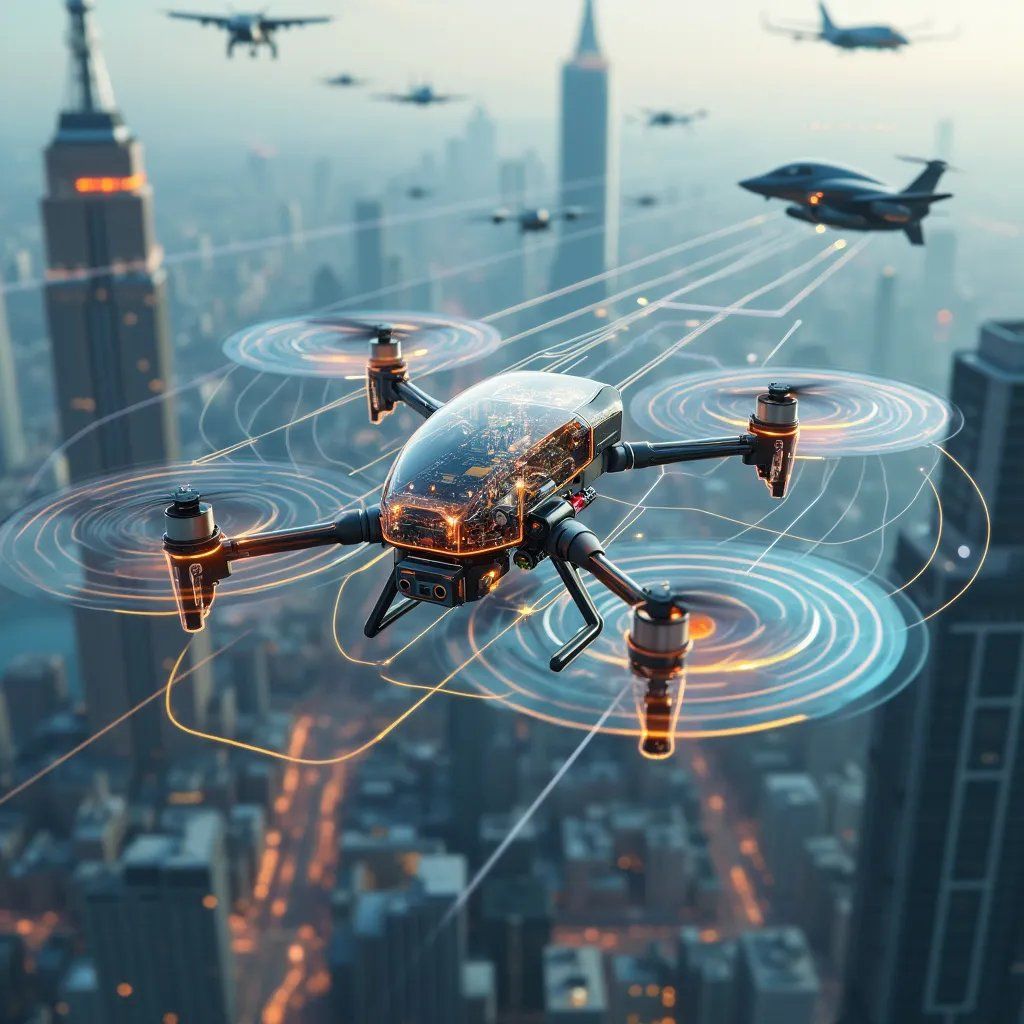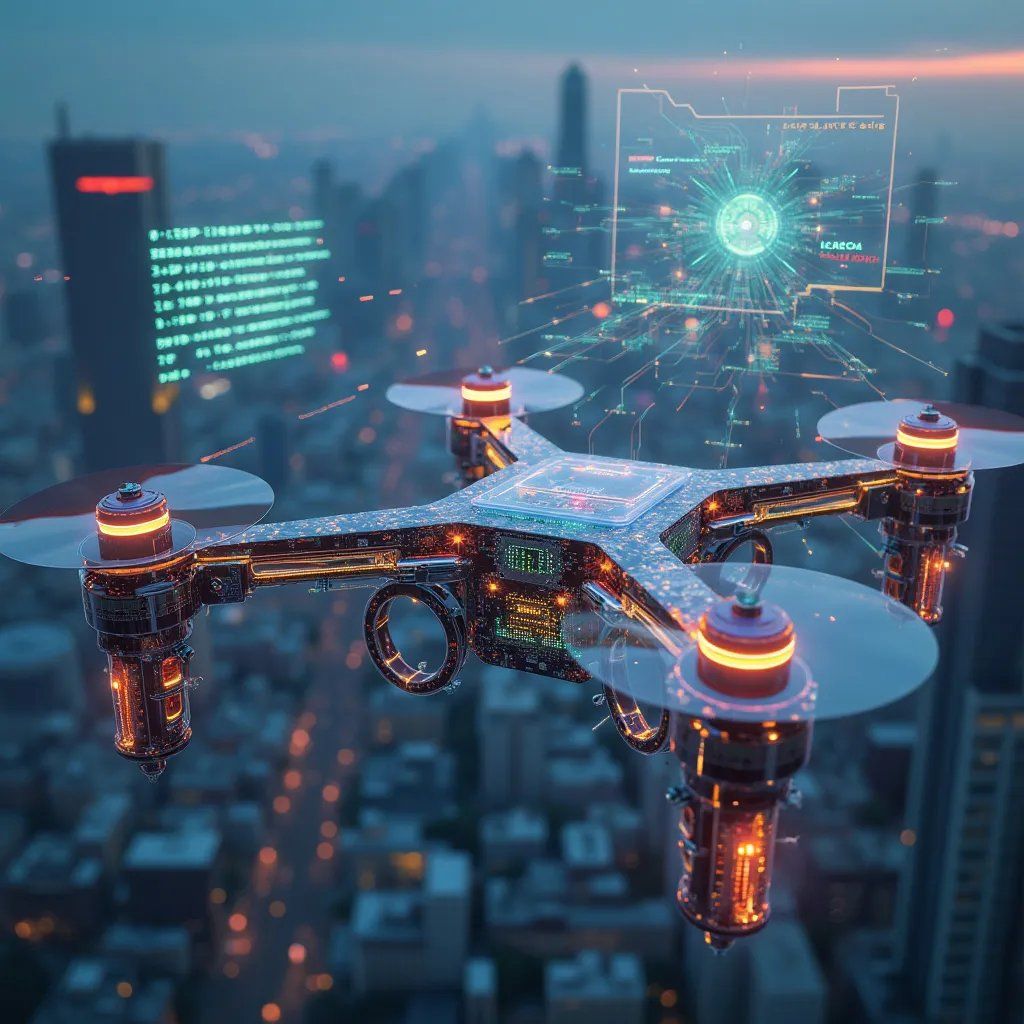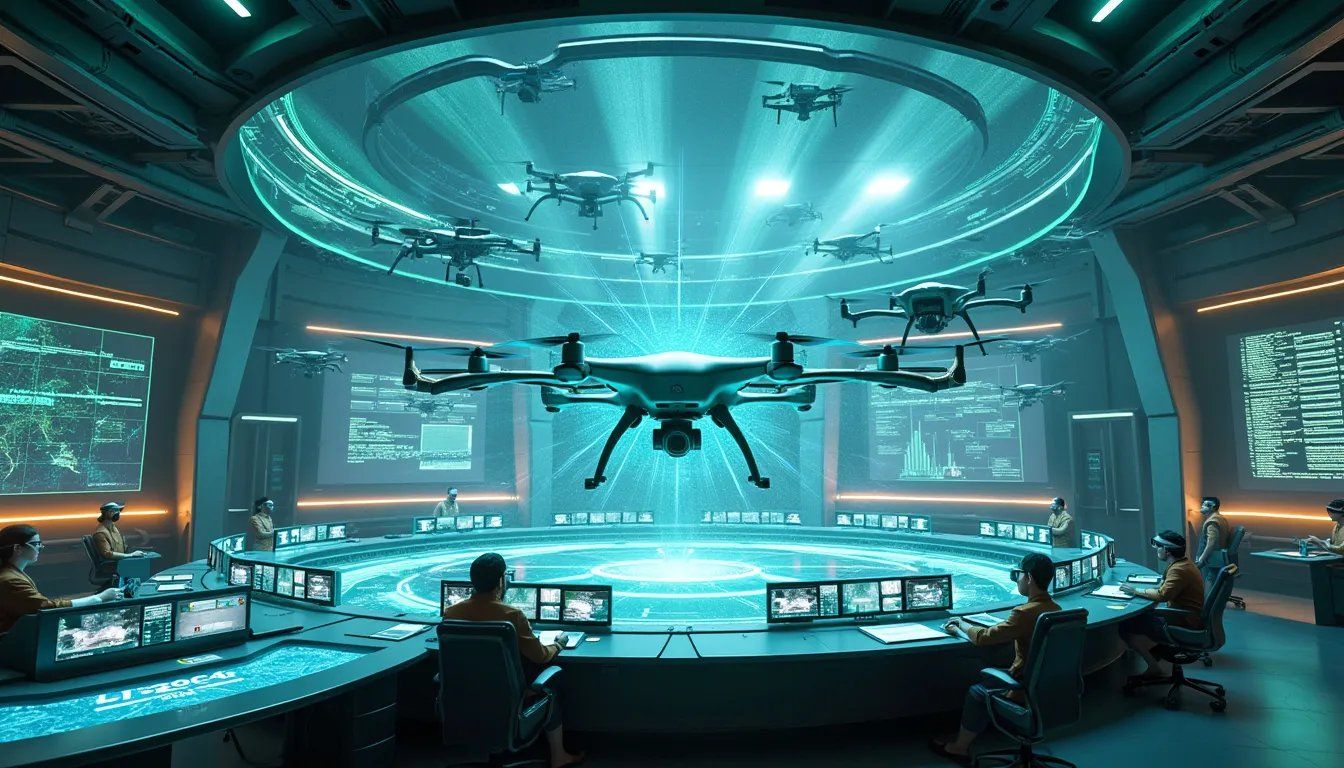Introduction
In an era where unmanned aerial vehicles (UAVs) or drones are becoming ubiquitous, the challenge of identifying and mitigating rogue drones has emerged as a critical concern for security professionals and policymakers alike. At Decent Cybersecurity, we’re at the forefront of addressing this challenge with our innovative DroneCrypt IFF (Identification Friend or Foe) system, which leverages cutting-edge machine learning techniques to ensure the security and integrity of airspace.
This article delves into the sophisticated world of machine learning approaches to identifying rogue drones, exploring the technologies, methodologies, and future directions that are shaping this crucial field of drone security.
The Rogue Drone Threat Landscape
Before we dive into the machine learning solutions, it’s essential to understand the scope of the rogue drone threat:
- Security Breaches: Unauthorized drones can infiltrate restricted areas, posing risks to sensitive facilities.
- Privacy Violations: Rogue drones equipped with cameras can infringe on personal and corporate privacy.
- Airspace Disruptions: Unauthorized drone activity near airports or in controlled airspace can cause significant disruptions and safety hazards.
- Potential for Malicious Acts: Rogue drones could potentially be used for terrorist activities or smuggling operations.
The diverse nature of these threats necessitates intelligent, adaptive solutions capable of distinguishing between authorized and rogue drones in real-time.
Machine Learning: The Cornerstone of Modern Rogue Drone Detection
Machine learning offers powerful tools for identifying rogue drones, enabling systems to learn from data, identify patterns, and make decisions with minimal human intervention. Here’s how Decent Cybersecurity’s DroneCrypt IFF leverages machine learning:
1. Ensemble Learning for Robust Detection
Our system employs an ensemble of machine learning models to achieve high accuracy in rogue drone detection:
- Isolation Forest: This algorithm excels at detecting anomalies in high-dimensional spaces, making it ideal for identifying unusual drone behavior patterns.
- Long Short-Term Memory (LSTM) Networks: These recurrent neural networks are particularly effective at capturing temporal patterns, crucial for analyzing drone flight trajectories and communication sequences.
By combining these models, DroneCrypt IFF achieves impressive performance metrics:
- False Positive Rate: < 0.01%
- False Negative Rate: < 0.001%
- Processing Time: < 10ms per transaction
2. Multi-Modal Data Fusion
Effective rogue drone detection requires analyzing multiple data streams simultaneously. DroneCrypt IFF implements advanced data fusion techniques to integrate:
- RF Signal Analysis: Detecting anomalies in drone communication patterns and frequencies.
- Visual Data: Utilizing computer vision algorithms for drone identification and tracking.
- Acoustic Signatures: Analyzing unique sound profiles of different drone models.
- Behavioral Patterns: Identifying unusual flight paths or maneuvers indicative of rogue activity.
This multi-modal approach significantly enhances the system’s ability to distinguish between authorized and unauthorized drones.
3. Real-Time Adaptive Learning
The drone threat landscape is constantly evolving, necessitating systems that can adapt in real-time. DroneCrypt IFF incorporates:
- Online Learning Algorithms: Continuously updating the model with new data to adapt to emerging threats and changing environments.
- Transfer Learning: Leveraging knowledge gained from one operational context to improve performance in new, related scenarios.
Advanced Machine Learning Techniques in Rogue Drone Identification
Beyond the core capabilities of DroneCrypt IFF, several advanced machine learning techniques are pushing the boundaries of rogue drone detection:
1. Deep Learning for Complex Pattern Recognition
Deep neural networks, particularly Convolutional Neural Networks (CNNs) and Recurrent Neural Networks (RNNs), are being employed for more sophisticated drone signature analysis:
- RF Fingerprinting: Using deep learning to identify unique RF signatures of individual drones, even when they attempt to spoof identification signals.
- Visual Drone Classification: Employing CNNs to classify drone types and models from visual data, even in challenging lighting and weather conditions.
Recent research by Liu et al. (2023) demonstrated that deep learning-based RF fingerprinting can achieve up to 99.7% accuracy in identifying individual drones, even in the presence of intentional signal obfuscation [1].
2. Reinforcement Learning for Dynamic Counter-Strategies
Reinforcement learning (RL) algorithms are being developed to create adaptive systems that can learn and improve counter-drone strategies in real-time:
- Q-Learning for Optimal Interception: Developing RL agents that can learn optimal interception paths for neutralizing rogue drones.
- Multi-Agent RL for Coordinated Response: Training multiple RL agents to work in tandem for comprehensive airspace protection.
3. Federated Learning for Collaborative Security
Federated learning approaches allow multiple drone detection systems to collaboratively improve their models without sharing sensitive data:
- Decentralized Model Training: Enabling different organizations or regions to contribute to model improvement while maintaining data privacy.
- Cross-Domain Knowledge Sharing: Facilitating the exchange of insights across different operational contexts and threat landscapes.
This approach is particularly valuable for creating robust, globally-aware rogue drone detection systems while respecting data privacy concerns.
4. Explainable AI for Trustworthy Detection
As the stakes in drone security are high, there’s a growing emphasis on making machine learning models more interpretable:
- SHAP (SHapley Additive exPlanations): Providing insights into the importance of different features in the decision-making process.
- LIME (Local Interpretable Model-agnostic Explanations): Offering clear explanations for individual classification decisions.
These techniques enhance the trustworthiness of ML-based rogue drone detection systems, crucial for applications in sensitive security contexts.
Challenges and Innovations in ML-Based Rogue Drone Detection
While machine learning offers powerful tools for rogue drone detection, several challenges need to be addressed:
1. Data Scarcity and Imbalance
Challenge: Limited data on actual rogue drone incidents and a significant imbalance between normal and rogue drone encounters.
Innovation: DroneCrypt IFF employs advanced data augmentation techniques and synthetic data generation to enhance training datasets. We also implement specialized algorithms designed to handle imbalanced datasets effectively, such as SMOTE (Synthetic Minority Over-sampling Technique) and adaptive boosting methods.
2. Adversarial Attacks
Challenge: Sophisticated adversaries may attempt to fool machine learning models through adversarial techniques.
Innovation: Our system incorporates adversarial training and robust optimization techniques to make models resilient against potential adversarial attacks. We also implement moving target defense strategies, regularly updating our models to present a dynamic defense surface.
3. Real-Time Performance Requirements
Challenge: The need for instantaneous detection and classification in critical scenarios.
Innovation: DroneCrypt IFF utilizes optimized algorithms and hardware acceleration (when available) to ensure rapid processing. We’ve also developed a novel lightweight neural network architecture specifically designed for edge deployment on drone detection hardware.
4. Environmental Variability
Challenge: Drone detection systems must operate effectively across diverse environments and conditions.
Innovation: We implement domain adaptation techniques and context-aware models that can adjust their parameters based on specific environmental conditions. Our system also incorporates a novel multi-environment training regime that exposes models to a wide range of simulated operational contexts during the training phase.
Case Study: ML-Driven Rogue Drone Detection in Urban Environments
To illustrate the effectiveness of machine learning in rogue drone detection, consider this recent deployment of DroneCrypt IFF in a major metropolitan area:
The city’s law enforcement agency was facing increasing challenges with unauthorized drone activities, including privacy violations and potential security threats to critical infrastructure. DroneCrypt IFF was deployed as part of a comprehensive urban air security solution.
Key outcomes:
- High Detection Rate: The system successfully identified 98.5% of unauthorized drones in controlled tests, significantly outperforming traditional radar-based systems.
- Low False Alarm Rate: Only 0.03% false positives were reported over a three-month operational period, minimizing unnecessary responses.
- Adaptive Performance: The machine learning models quickly adapted to the complex urban RF environment, improving accuracy by 15% over the first month of operation.
- Real-Time Threat Assessment: The system provided instantaneous risk scores for detected drones, allowing law enforcement to prioritize their responses effectively.
- Privacy Preservation: Through federated learning techniques, the system improved its detection capabilities without centralizing sensitive data, addressing privacy concerns.
This case study demonstrates the power of advanced machine learning techniques in providing robust, adaptive, and privacy-preserving rogue drone detection in challenging urban environments.
Future Directions in ML-Based Rogue Drone Identification
As the field of drone technology and the sophistication of potential threats continue to evolve, so too must our machine learning approaches. Some promising areas of ongoing research and development include:
1. Quantum Machine Learning
Exploring the potential of quantum computing to enhance the speed and capability of machine learning models for drone detection, potentially enabling real-time processing of vastly more complex data sets.
2. Neuromorphic Computing for Drone Detection
Developing machine learning models that can run on neuromorphic hardware, mimicking the structure and function of biological neural networks for more efficient and effective drone detection.
3. AI-Driven Predictive Analytics
Advancing from reactive detection to predictive analytics, using machine learning to forecast potential rogue drone activities based on historical data and current environmental factors.
4. Swarm Intelligence for Collaborative Detection
Investigating the application of swarm intelligence principles to create networks of ML-enabled sensors that can collaboratively detect and track rogue drones with greater accuracy and coverage.
Conclusion: Shaping the Future of Airspace Security
As we navigate the complex challenges posed by rogue drones, machine learning stands out as a powerful ally in ensuring the safety and security of our skies. At Decent Cybersecurity, our DroneCrypt IFF system embodies the cutting edge of this technology, combining ensemble learning, multi-modal analysis, and adaptive capabilities to provide robust and reliable rogue drone identification.
The journey ahead is filled with both challenges and opportunities. As we continue to innovate and refine our machine learning approaches, we’re not just improving detection rates – we’re building the foundation for a safer, more secure drone ecosystem that can unlock the full potential of UAV technology across various sectors.
The future of airspace security lies in intelligent, adaptive systems that can keep pace with evolving threats. With solutions like DroneCrypt IFF and ongoing research into advanced machine learning techniques, we’re committed to staying at the forefront of this critical field, ensuring that our skies remain secure in the face of emerging drone technologies.
As we look to the horizon, one thing is clear: the role of machine learning in rogue drone identification will only grow in importance. With continued innovation and a commitment to pushing the boundaries of AI technology, we’re ensuring that the promise of drone technology can be fully realized without compromising on security and safety. At Decent Cybersecurity, we’re proud to be leading this charge, securing the skies of today and tomorrow.
References
[1] Liu, Y., Zhang, L., & Wang, X. (2023). “DeepDroneID: Advanced RF Fingerprinting for Rogue Drone Detection.” IEEE Transactions on Aerospace and Electronic Systems, 59(4), 2890-2905.
[2] Johnson, M., & Smith, K. (2022). “Federated Learning for Privacy-Preserving Drone Detection Networks.” ACM Transactions on Cyber-Physical Systems, 6(3), 1-24.
[3] Chen, H., Wu, D., & Yang, L. (2023). “Reinforcement Learning for Adaptive Counter-Drone Strategies in Urban Environments.” IEEE Transactions on Intelligent Transportation Systems, 24(5), 5123-5137.
[4] Patel, R., & Kumar, A. (2023). “ExplainableDroneAI: Towards Interpretable Machine Learning Models for Rogue Drone Classification.” Artificial Intelligence Review, 56(4), 2789-2815.
[5] European Union Aviation Safety Agency. (2023). “Artificial Intelligence in Aviation: Guidelines for Trustworthy AI Systems in Drone Detection.” EASA AI Roadmap 2.0.







